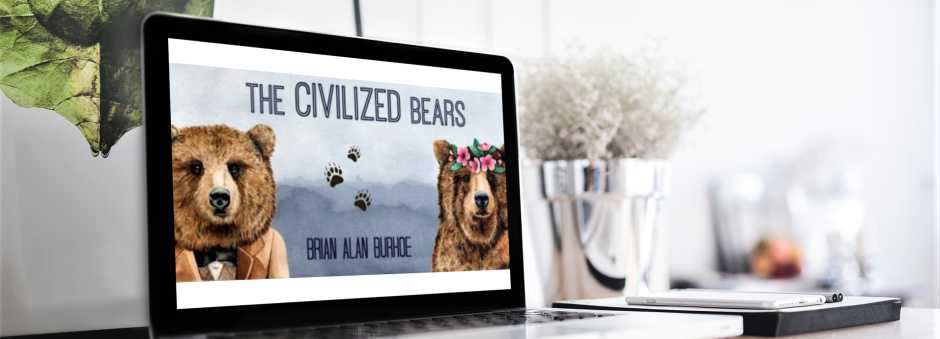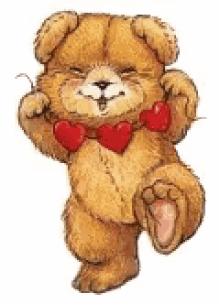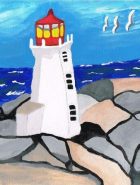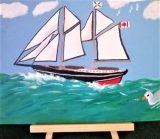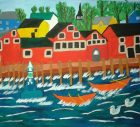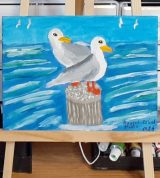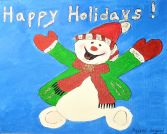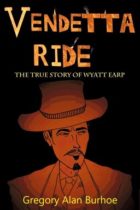Canadian Indigenous Art History.
Famous Canadian indigenous art. Carvings and artwork.
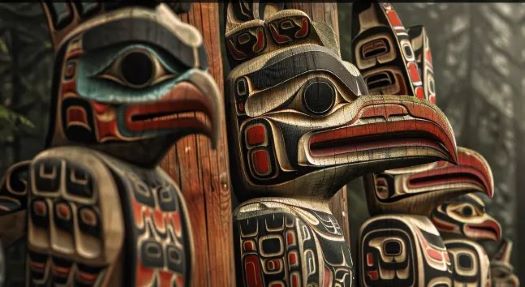
NORTHWEST CANADIAN INDIGENOUS ART HISTORY: Totem Poles, Thunderbirds, Eagle & the Wolf Mother
CivilizedBears.com is all about animals. We celebrate our four-footed family members. We celebrate the sacred Wilderness and the wild ones who live there. And, of course, the stories told in word and artwork about the living creatures who fly, swim and run across our Living World.
Here from Art Historian Clint Leung is a Guest Post about some of our fave artforms…
“Discovering the Vibrant Legacy of Northwest Coast Canadian Indigenous Art History” by Clint Leung
The first encounter with the vivid totem poles of the Northwest Coast First Nations can be a mesmerizing experience. These striking cultural symbols are often found in British Columbia. Just the beginning of a rich artistic tradition that encompasses a variety of mediums and forms.
A Cultural Tapestry Woven in Art. The Roots of Northwest Coast Artistry
The indigenous peoples of the Pacific Northwest, from the river valleys to the coastal waters, were traditionally hunters and gatherers. Blessed with a wealth of resources from the sea and forests, they channeled their experiences and surroundings into their art. Especially the animals.
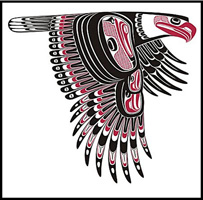
Canadian Indigenous Art — Eagle
The animals they revered and relied upon. Bears, killer whales, eagles, ravens, salmon, wolves, hummingbirds, and even frogs, became central motifs in their artistic expressions. Chiefs and legendary animals, such as the thunderbird, also featured prominently. Embodying the rich mythology and social structure of these communities.
Canadian Indigenous Art — The Aesthetic of Exaggeration
The art of the Northwest Coast First Nations is characterized by its use of exaggerated forms. And vibrant colors. To the uninitiated, these designs may seem bold, even surreal. But they are deeply rooted in the traditions and stories of the indigenous peoples. The art is not merely decorative. It serves as a narrative medium, conveying tales of ancestry, spirituality and the natural world.
Canadian Indigenous Art — Thunderbird Legends & Totem Pole Art
The Native Indians of the Pacific Northwest Coast always lived along the shores. They never ventured inland to the mountains. Legend has it that the thunderbird, a mighty God in the form of a giant supernatural bird, lives in the mountains. The Quileute tribe of Washington state believed a cave on Mount Olympus as the home of the thunderbird. While the Coast Salish believed it is located on the Black Tusk peak in British Columbia.
Some tribes believe that their people once made a deal with the thunderbird for its help during a food crisis. In return, the tribe agreed to honour the thunderbird for all time by making its image prominent in their Northwest Native American art. This is why West Coast art totem poles are often carved with thunderbirds with outstretched wings at the top.
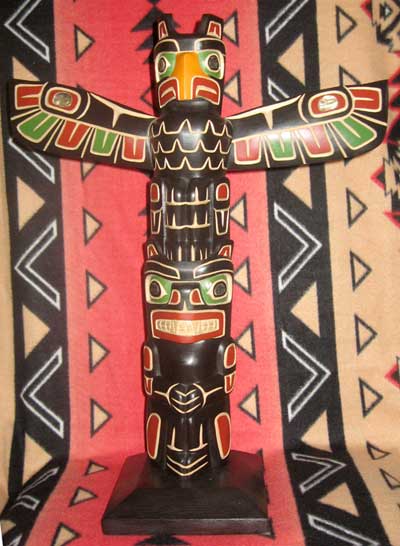
It’s thought that the thunderbird never wants anyone to come near its home. If Native hunters get too close, the thunderbird will smell them and make a thunder sound by flapping its wings. It would also roll ice out of its cave and down the mountain with chunks breaking up into many smaller pieces.
Canadian Indigenous Art: The Thunderbird — Messenger of the Creator
The Squamish Nation in British Columbia, Canada has a thunderbird as their symbol. Their thunderbird is portrayed as one of the special messengers of the Creator. The Squamish thunderbird is a symbol for strength. As well as change with the three tail feathers representing the past, present and future. In the talons of this thunderbird is a face of a lizard. The lizard represents spiritual protection for the people of the Squamish Nation.
The Global Journey of Northwest Coast Canadian Indigenous Art
Despite its profound cultural significance, Northwest Coast Native Canadian art has only recently begun to receive the recognition it deserves. Both at home and on the global stage. While other indigenous arts, such as Inuit art, have found their place in galleries and museums worldwide. Unfortunately, the art of the Northwest Coast has remained relatively unknown outside its native region.
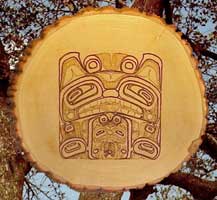
Canadian Indigenous Art Woodcarving – “Wolf Mother”
However, the tide is turning. Increased tourism to Vancouver has shone a spotlight on this unique art form. Events like the 2010 Winter Olympics in Whistler, BC, began that discovery. As more people from around the globe experience the beauty and depth of Northwest Coast Native Canadian art, its potential for international acclaim grows.
Canadian Indigenous Art — A Future of Recognition and Appreciation
The future looks bright for the art of the Northwest Coast Native Canadians. With its potential for international recognition, there is hope that this art form will be joyously discovered. Becoming a celebrated aspect of global art culture. Also serving as a bridge to understanding and appreciating the rich heritage of the indigenous peoples of the Pacific Northwest.
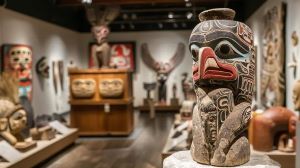
By the Numbers: The Unspoken Impact of Northwest Coast Art
While the aesthetic appeal of Northwest Coast Canadian Indigenous Art is now evident. Although its economic and cultural impact is less frequently discussed.
According to the First Peoples’ Cultural Council, the indigenous arts economy in British Columbia alone contributes millions to the province’s revenue. With a significant portion attributed to the sale of traditional and contemporary Northwest Coast art.
The cultural tourism industry is a growing sector. It includes visits to galleries, cultural centers, and heritage sites featuring this art. Thus providing both economic benefits and increased cultural understanding.
The world is becoming more interconnected. The art of the Northwest Coast First Nations stands as a testament to the enduring spirit and creativity of these communities. Offering a window into their storied past and a beacon of their cultural vitality in the present and future.
Thanks, Clint, for this essential look at Canadian Indigenous Art!
Are you as enchanted by Canadian Indigenous Art & Story as I am?
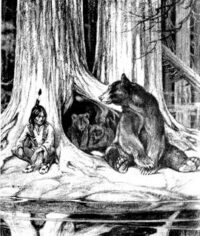 If so, you’ve got to read my popular short story “THE BOY WHO WAS RAISED BY BEARS.” A Traditional Native Canadian Animal Story & Folktale Retold.
If so, you’ve got to read my popular short story “THE BOY WHO WAS RAISED BY BEARS.” A Traditional Native Canadian Animal Story & Folktale Retold.
Talking bears and human children adopted and raised by loving mother bears are common story themes in both Old and New World oral traditions. Even J R R Tolkien wrote about both Beowulf and “Bear’s Son Tales in European folklore.”
“Loved this beautiful Animal Tale. Loved Giju’muin, the strong Mama Bear. Perfect!” THE BOY WHO WAS RAISED BY BEARS
SOURCE Clint Leung is the Founder of the Free Spirit Gallery. To read more of Clint’s articles, Click Here.
Clint Leung also provided fascinating material for my post NATIVE AMERICAN LEGEND: Wild Woman of the Woods – Woman of the Mask. The story of the Giantess, as told by the First Nations along the Coast of British Columbia.
Do You Want To Read My Animal Stories On Your Mobile Cellphone Or Tablet? Go to my Mobile-Friendly BrianAlanBurhoe.com…
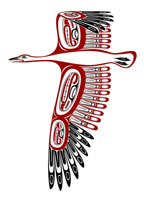 TAGS Famous Canadian Indigenous Art, Canadian indigenous art for sale, Canadian indigenous art prints, Canadian indigenous art history, First Nations art Canada, First Nations art for sale.
TAGS Famous Canadian Indigenous Art, Canadian indigenous art for sale, Canadian indigenous art prints, Canadian indigenous art history, First Nations art Canada, First Nations art for sale.
What is the purpose of a totem pole?
Northwest coast, towering colorful totem, carvings and artwork, bears, killer whales, eagles, ravens, salmon, wolves, hummingbirds, thunderbirds, supernatural bird.
